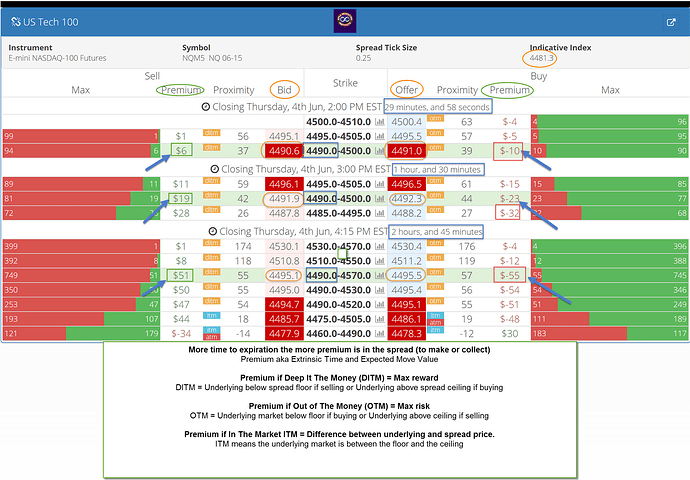By Darrell Market
Premium is time value, so as time passes, premium will decline. Considering premium as a trader, you are either making it or paying it. Which one do you want to do?
In other articles in this series, (See What Is Premium? and Premium: How To Calculate And Understand It), an example was given using the US Tech 100 Nadex spreads which uses Nasdaq as its underlying instrument.
US Tech 100/Nasdaq Example
To continue using that same example, let’s say again that you sold at 4495 with the current market being at 4482 and the floor being at 4490. This would make your contract Deep In The Money (DITM). On a DITM contract, your max reward is your premium.
In this scenario, your premium on this contract is $50. You are saying that you think the market is going to go down. It does and you make your $50. If the market stays flat at 4482, you still make your $50. The market can move eight points up to the ceiling of 4490 and you still make your $50 because it is premium; it is time value.
Drop The Binary Mentality
If you normally trade binary options, you have to drop the binary mentality of winning or losing it all. When trading Nadex spreads, you would make $1 less for each point it goes up past the ceiling of 4490. If it settled at 4490.1, you’d make $49. You would not lose it all as you would when trading binaries. When it reaches the price you sold it at of 4495, you would be at breakeven. What if it settled at 4495.1? You would be down $1. Remember also that spreads can be up to 1000 ticks wide, which is $1000 worth of value. It is not $100 like a binary. Spreads can be many different sizes. Your max profit when you sell is down to the floor. Your max profit when you buy is up to the ceiling.
Real Examples
Using premium to your advantage is a great tool to have in your trading arsenal. The following image shows two live trades that are using time value to make real money.
By looking at the Profit/Loss column and at the Time Left column, you can see that both of these trades are profitable and still have time value working in their favor. The first trade is currently up $386 on five contracts with the second trade up $107 for a total current profit of $493. This is on the same market as the examples cited in these articles which were then trading at 4482. These trade’s average entry prices were 4503 and 4506 respectively. If you look at the current market value of 4495.4, you can see how having time value on your side allows premium to work in your favor. Time left is two hours and thirty-one minutes. Strike prices would not be available currently to bring in profits like the ones shown above.
Summary Of Live Trade Examples As time went on, from the image above, more premium was able to be collected, because as the time is sucked out of the option, you collect premium on that time value. A total of $816 will be made on the above contracts and that is simple time value. It is also implied volatility value, which means expected movement. If you think about it, if there is less time, in most cases, there is less expected movement. An exception to that statement would be before news is released.
An example of movement before a news release would be Google options. The price of a Google option is really expensive before the earnings come out, but once the report is released, there is what is called the volatility crush. That is when implied volatility drops because the expected movement has happened and it drops down. Sometimes you can make money on the drop in the movement.
There is time and expected movement. You can either make the premium or pay the premium. Normally, you can make money on both sides.
If you would like to further your trading education visit www.apexinvesting.com a service of Darrell Martin.


